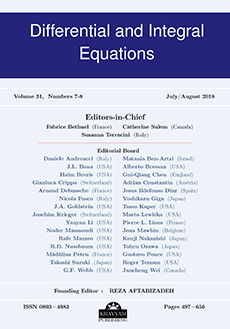Abstract
The ability of eukaryotic cells to actively move along different substrates plays a vital role in many biological processes. A key player in these processes is the cytoskeleton. In [7], we introduced a minimal hyperbolic-parabolic model for the reorganization of the actin cytoskeleton of a generic cell resting on a flat substrate and turning into a polarized state upon some external cue. In this paper, we derive moving boundary conditions for that model and by this allow for the description of actual motion. For the free boundary problem we prove short time well-posedness for a wide class of initial conditions and analyze the emergence of Dirac measures in the densities of actin filament tips. These have a biophysical interpretation as sharp polymerization fronts which are experimentally observed in [19], for example. Further, simulations will illustrate the motion of an initially symmetric resting cell and the emergence of sharp actin fronts from initially smooth distributions.
Citation
Jan Fuhrmann. Angela Stevens. "A free boundary problem for cell motion." Differential Integral Equations 28 (7/8) 695 - 732, July/August 2015. https://doi.org/10.57262/die/1431347860
Information





